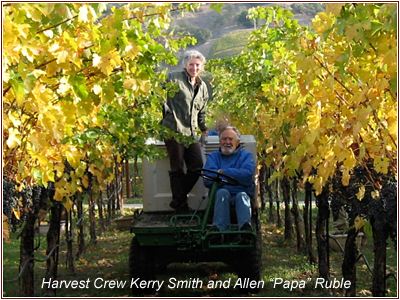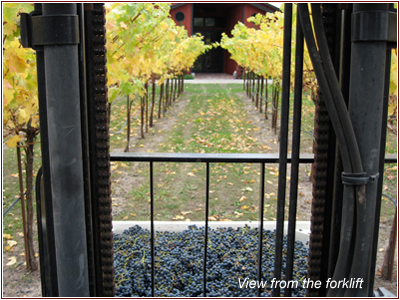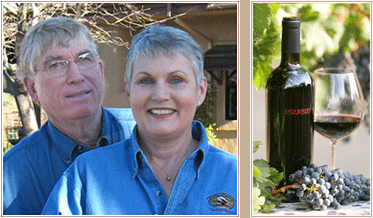
Tom Scott Vineyard Newsletter - Autumn 2011 - Barnburner Cabernet Sauvignon

Dear Friends,
A beautiful vintage has come out of the field and into the winery. This year our fruit was finally picked on November 3rd! We called together friends, family and a professional crew and got the crop in before the rains came again. We concluded the fruit was as ripe as it was going to get; we weren’t going to see many more warm days and the plants were beginning to shut down for the season... so, as last minute as we dared, we brought the fruit in!
 Like last year, due to a cooler summer, we had to work a little harder at canopy management. By thinning shoot growth and removing some leaves, we allowed more light and aeration into the vine. While many vintners in the valley experienced a reduced crop due to damage of the fruit-set by rain in the spring and then the grape-spoiling Botrytis fungus caused by rain and cooler days in the early fall, our vineyard had no damage and our yield was, as usual, about 5 tons per acre. Our good crop was the result of several factors. Like last year, due to a cooler summer, we had to work a little harder at canopy management. By thinning shoot growth and removing some leaves, we allowed more light and aeration into the vine. While many vintners in the valley experienced a reduced crop due to damage of the fruit-set by rain in the spring and then the grape-spoiling Botrytis fungus caused by rain and cooler days in the early fall, our vineyard had no damage and our yield was, as usual, about 5 tons per acre. Our good crop was the result of several factors.
Our late pruning, mid-Feb through the first week in April this year, meant our fruit was delayed in budding and wasn’t in that sensitive “set period” when unusual spring rains came. So, our vines experienced little to no “shatter” or “shotberry” which is caused by an interruption of fruit pollination, resulting in a reduction in clusters and berries. Our style of trellising, a modified open lyre, and our style of pruning, head trained cane pruned, allows for maximum light and air penetration into the vine. This helps the canopy dry out following rains reducing the threat of Botrytis. Additionally, Bordeaux varieties are resistant to mildew damage having been developed in the cool and rainy Bordeaux region. Our valley location also plays a part in our healthy crop, the flat valley floor reduces cool damp pockets and the north and south winds keep things aired out and dried out.
 This year’s cooler weather resulted in flavors that developed at lower brix (or sugar.) In warmer summers, the brix develops quickly, often hitting 27 degrees by the time the fruit has reached our desired ripeness. But in these cooler summers where the flavors (ripeness) have developed slower, so has the brix, resulting in lower sugars at harvest. This year our fruit came in at about 25 degrees brix. The lower brix combined with the overall ripeness of the fruits, gives us an elegant wine, which according to our winemaker, Bill Ballentine, seems to make itself. This year’s cooler weather resulted in flavors that developed at lower brix (or sugar.) In warmer summers, the brix develops quickly, often hitting 27 degrees by the time the fruit has reached our desired ripeness. But in these cooler summers where the flavors (ripeness) have developed slower, so has the brix, resulting in lower sugars at harvest. This year our fruit came in at about 25 degrees brix. The lower brix combined with the overall ripeness of the fruits, gives us an elegant wine, which according to our winemaker, Bill Ballentine, seems to make itself.
Another interesting note this year is that for the first time ever, all of our varietals were ready to harvest at the same time, even our Merlot! Traditionally the Merlot has been ready to harvest 10 days to two weeks ahead of the Cabernet Sauvignon, Cab Franc and Petite Verdot, but this year due to the slow ripening of the entire vineyard and mild weather, the Merlot was able to hang out and come in with the rest.
It makes perfect sense to us that the fall is when we pause to give thanks, because for us, fall is the end of our year, the close of another vintage. The harvest is in and the plants are shutting down for the winter, resting and gaining strength for spring when the cycle begins again. We’re thankful for this wonderful life we live in this beautiful place, the stunning wines we’re able to share with so many wonderful people and this year we’re thankful for our daughter Brandyn and son-in-law Brady who’ve given us an amazing new grandson and future tractor driver, Spencer Thomas Waite.
 Tom and Lauren Scott Tom and Lauren Scott
www.tomscottvineyard.com
www.tomscottvineyard.com/wineshop
info@tomscottvineyard.com
Back-issues of our Notes

|



